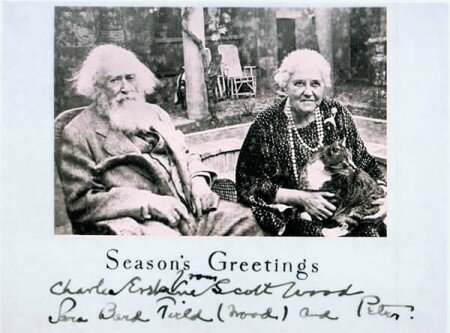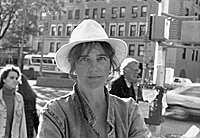For Oregon newbies who want to get to know their new home better, here’s some advice. You can’t go wrong going straight to the source, and reading Oregon authors. Even where they do not take Oregon as their subject (but choose, say, Pancho Villa), much is revealed about the regional character just in the way they write.
Walt Curtis compiled this list of his top recommended Oregon books originally for the Clinton Street Quarterly. It is still the best list I have ever seen: direct, pure, idiosyncratic. Just like Walt.
Walt Curtis Recommends
1. Far Corner: A Personal View Of the Pacific Northwest by Stewart Holbrook. Debunking and delighting, the Portland historian writes of the Wobblies, Erickson’s Saloon, Aurora Colony, logging, and the myths and symbols of our region of the U.S.
Anne’s commentary: Stewart Holbrook cast a long shadow. Brian Booth edited a collection of Holbrook essays, Wildmen, Wobblies and Whistle Punks, and spoke about Holbrook at a recent Dill Pickle Club meeting. John Daniels chose The Far Corner as the title for his most recent collection of essays as a tribute to Holbrook.
2. The Selected Poems of Hazel Hall is the crippled seamstress’ marvelous work. Beth Bentley introduces this only volume of Hall in print, which needs to be amplified. An early feminist, her distinguished poetry deserves national attention once again. She is as good as Emily Dickinson.
Anne’s commentary: As Walt predicted, a second collection of Hazel Hall’s poetry did find its way into print. John Witte published a collection with OSU Press in 2000. Oregonian film critic Stan Hall, no relation to Hazel Hall, named his daughter after this forgotten Portland poet.
3. The Distant Music by Harold Lenoir Davis. This chronicle of the Mulock family and their relationship to the land is Davis’ last novel. Winner of the Pulitzer Prize in 1936 for Honey in the Horn, Davis wrote as well as anyone in the Pacific Northwest, including Ken Kesey. He has justly been compared with Faulkner and Twain.
Anne’s commentary: Walt’s contrarian choice, to list a lesser known work by Davis rather than his Pulitzer Prize winner, means there must be something to The Distant Music. I have not read it but this year I will.
4. The Conquest, or the True Story of the Lewis and Clark Expedition by Eva Emery Dye. Dye popularized the expedition, creating a memorable feminist heroine in Sacajawea. She is the Northwest’s finest historical novelist, readable, upbeat, well researched. Her books should be brought back into print so school kids can get a sense of Northwest history. The Oregon Trail and all of that! Go to the library to read her work.
Anne’s commentary: Eva Emery Dye uses dialogue in a way which astonishes modern readers — putting words in the mouths of all her historical figures – but what a storyteller! Read her (out of print, as Walt noted) novels for a still vivid portrait of a community trying to balance their ideal of a democratic society where all men are equal against their own historical record of displacing the First Oregonians.
5. Life Among The Modocs: Unwritten History by Joaquin Miller. A seventeen year old boy went to live with gold miners and Indians near Mt. Shasta. From his experience would come an American classic. Miller himself would become the archetype of the Western man, making Buffalo Bill jealous.
Anne’s commentary: Joaquin fights both for the Indians and against the Indians, ping ponging from one side to the other. He knows exactly who he is and where his primary allegiance lies — with himself. The self portrait of a scoundrel in love with language. Is this the blueprint for future Oregon wildmen Ken Kesey and Gus Van Sant? Written in 1873, when Joaquin Miller was a lionized poet living in London.
6. The Bridge Of The Gods, a Romance of Indian Oregon by Frederic Homer Balch is reminiscent of Nathaniel Hawthorne. The missionary Cecil Grey has been drawn to the Northwest by a vision of the bridge and a need to convert natives to Christianity. Himself a melancholy preacher, Balch died tragically at age 29 of tuberculosis.
Anne’s commentary: Walt has been after me to read this 1890 novel for as long as I can remember. I promise this year I will repair to Cascade Locks to sit and read this book within view of the steel cantilevered Bridge of the Gods which replaces the land bridge commemorated by its title. I will do this as a tribute to Walt, and despite the great misgivings I have about works of art created by melancholy preachers. Available on Google Books.
7. Heavenly Discourse by Charles Erskine Scott Wood. Can you imagine someone’s life spanning the era from the days of Chief Joseph to the bombing of Pearl Harbor? Wood’s satirical sketches, disgracefully out of print, would rock conservative minds even today. Intelligent, classical, radical, libertarian, “Ces” Wood is the patriarch of Portland arts and letters.
Anne’s commentary: Walt is right. C. E. S. Wood is the patriarch of Portland arts and letters. He commissioned the Skidmore fountain, helped found the public library, worked as a corporate lawyer for lumber companies by day and as an essayist for radical East Coast magazines by night. A litmus test: You’re not a real Oregonian if you don’t know who he is.
8. Insurgent Mexico by John Reed, the Northwest’s most internationally acclaimed author! What do we gringos know of the history of Mexico, our closest neighbor? John Reed was there, riding with Pancho Villa in 1913. Raw, passionate, poetic, the great journalist gives us a visceral, unforgettable account.
Anne’s commentary: Another contrarian choice by Walt, since Reed is more famous for writing Ten Days Which Shook The World, his eyewitness account of the Russian revolution.
9. The Singing Creek Where The Willows Grow : the rediscovered diary of Opal Whiteley by Ben Hoff . This rediscovered diary and biography is a standard for the re-issuing of Northwest classics! Opal is the “flower child”, charismatic and schizophrenia, who captivated readers of the Atlantic Monthly in 1920. She grew up in a Cottage Grove lumber camp, and is still alive in a mental hospital in London. Fascinating story!
Anne’s commentary: Since Walt wrote this, Opal Whiteley died. I belong to the camp which classifies her early childhood literary achievements as fraud. Hoff takes the opposing view. Her story, real or no, is part of Oregon history.
Walt’s original list, written for the Clinton Street Quarterly, was a full dozen titles. The additional three were by Washington State writers.
Here again is Walt:
1. The Egg and I by Betty MacDonald. Life on a Puget Sound chicken ranch. Ma and Pa Kettle are their closest neighbors! This book is still a bestseller. A housewife’s eye-view of geoducks and other curiousities peculiar to our landscape, including the people.
2. Paul Bunyan by James Stevens. In a literary manner, Stevens popularized the mythical logger of American folklore. Stevens also co-authored Status Rerum, a manifesto on the deplorable state of Northwest letters, with his close friend, H. L. Davis.
3. Skid Road by Murray Morgan. The first skid road, logger’s Valhalla or bowery was located in Seattle. Where the human and wood debris were dumped in the bay! Ox teams skidded logs to Yesler’s mill. Doc Maynard took over and the red light district became legendary.



0 responses so far ↓
There are no comments yet...Kick things off by filling out the form below.
Leave a Comment